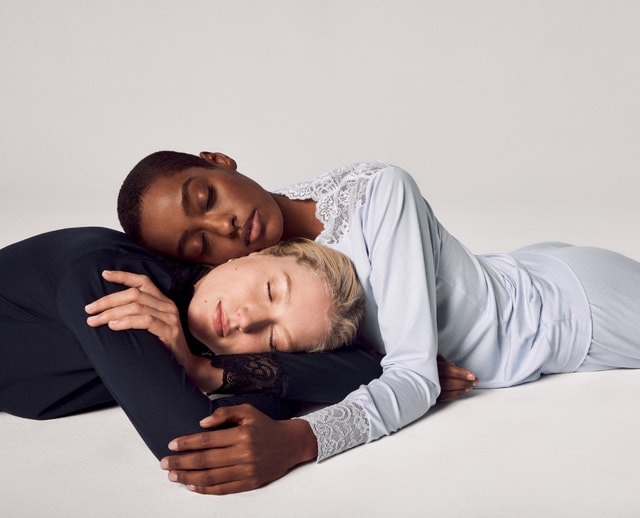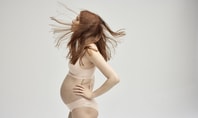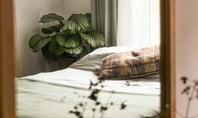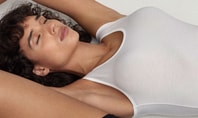Sleep positions: the ideal sleepwear for a restful night’s sleep
There are many factors that play into us getting a good night’s sleep – these include having a quiet room to rest in, a cosy bed, a comfortable sleep position and the ideal sleepwear. According to a survey on Germans’ quality of sleep in 2021, a quarter of respondents say they sleep badly or very badly, and only a quarter of respondents say they sleep well or very well. We’ve been honing our sleepwear range for over 80 years to meet the specific requirements of every sleep position. Discover the perfect sleepwear and important information about your sleep position, so you can wake up refreshed and feeling ready to tackle the day.
by Rana Silva
April 5, 2024•4 min reading time

Find the perfect nightwear for your sleeping position.
Table of Contents
What sleep positions are there?
According to a study by the Norwegian University of Science and Technology (NTNU), there are three main sleep positions: the front position, the back position and the side position. While 54.1% of study participants slept on their side, 37.5% slept on their back and only 7.3% of the test subjects slept on their stomach; approximately 1% of the 664 test subjects had no preferred sleeping position. These clear groupings into different sleep positions illustrate how we all have individual needs for getting a good night’s sleep. We want to help improve your sleep quality as much as possible with the following information and recommendations.

Statistics of sleeping positions: Supine position 37.5%, lateral position 54.1%, prone position 7.3%, no preference 1%.
Side-sleepers
Most people sleep on their side. In this position, your lower arm is usually positioned under your head and your legs are slightly bent. Sleeping on your left side offers some benefits for your heart, lymphatic system and digestion compared to sleeping on your right side, and heartburn also occurs less frequently.
Side-sleepers can improve their sleep quality by opting for sleepwear without any elements on its sides, such as ruffled sleeves or trouser pockets. For nightdresses and nightshirts, opt for a length of at least 120 cm so that your legs are still covered when bent and the fabric doesn’t ride up over your buttocks.
Back-sleepers
The second most popular sleeping position is on the back. Back-sleepers have plenty of options when choosing their sleepwear, since it usually doesn’t have any bothersome elements, such as hoods, on the back. If you’re a snorer who sleeps on your back, it’s a good idea to raise your upper body with a pillow or shift to a different sleeping position.
Stomach-sleepers/front-sleepers
When you sleep on your stomach, your arms are usually positioned next to your body or under your head, which is turned to the side. From a health perspective, the front position is only recommended to a limited extent, as it can lead to stiffness, circulation problems and breathing difficulties.
If you nevertheless want to be able to sleep comfortably on your stomach, avoid sleepwear that has any button plackets or other elements on the front. Also look for fabrics with plenty of elasticity if you’re a stomach-sleeper who likes to have one of your legs bent at night.
Foetal position
The foetal position is a variation of the side position, whereby the knees are pulled in close to the chest and the arms are often wrapped around the legs. While the foetal position can temporarily relieve tension in the back, we don’t recommend staying in it all night, as this can cause pain in the neck and pelvis.
Just as with the side position, you should also avoid sleepwear with anything on its sides if you sleep in the foetal position. Short nightdresses and nightshirts ride up quickly in this curled-up position; instead, we recommend elasticated pyjamas with cuffs that mould to the body perfectly and provide the necessary freedom of movement.
Active sleepers
Although most people have a favourite position for sleeping in – even if they change it from time to time – this is not the case for everyone: active sleepers do not have a preferred sleep position and move around a lot during the night. This is also completely normal, and frequently changing your sleep position can even prevent poor posture caused by permanent, one-sided overuse.
To ensure that active sleepers aren’t restricted while moving around at night, they should opt for sleepwear that offers them plenty of freedom of movement. Here, too, we recommend cuffed pyjamas that move with the body in any position. It’s a good idea to avoid button plackets, side elements, or short nightdresses or nightshirts that can easily ride up.
Which sleep position is the healthiest?
The healthiest sleep position is on your back. This is because your body weight is optimally distributed, with the pressure taken off your spine and joints. In addition, your legs are fully extended when you’re in the back position, meaning your muscles and tendons won’t tighten up. If you suffer from reflux or heartburn, lying on your left side is also a good alternative to lying on your back.
Getting used to a new sleep position
For some people, their usual sleep position doesn’t do them any favours – for example, if they suffer from stiffness, snoring, sleep apnoea or heartburn. However, changing your sleep position for good is easier said than done. What’s important is that you get into the ideal sleep position as you are falling asleep. You can use pillows as a barrier to prevent you from rolling back into your usual pose; long nursing pillows are ideal for this. Once your body has become accustomed to your new, healthy sleep position, it won’t be long before you are able to manage without these aids.

Keep your sleeping environment comfortable and calm to promote a successful transition.
Even if your sleep position isn’t causing you any complaints, you should still make sure that you are as comfortable as possible when sleeping. Special pillows for side-sleepers and stomach-sleepers/front-sleepers take the pressure off the body and ensure a straight spine, while choosing the ideal sleepwear for your sleep position also supports good-quality sleep – allowing you to continue to sleep in your favourite position in comfort.
DEEPSLEEPWEAR
If you’re on the hunt for comfortable pyjamas suited to your sleep position and the ideal sleepwear for your sleep type, our DEEPSLEEPWEAR collection is just what you need. The three innovative material blends have cooling, temperature-regulating and warming effects, and can be combined to create a number of options – no matter how you like to sleep.

Discover more interesting blog posts:


